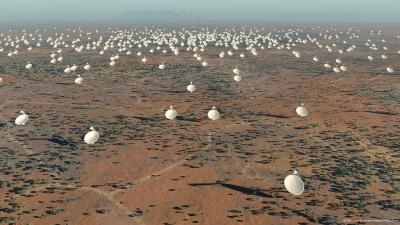Square Kilometre Array (SKA)
The SKA will be the world's largest radio telescope. It is not 1 dish, but thousands of radio antennas that all work together. It will be 50 times more sensitive than any other radio telescope. It will survey the sky 10,000 times faster than ever before.

Credit: SKA
The SKA will be used to answer big questions in science like:
- Was Einstein's theory of gravity correct?
- What are dark matter and dark energy?
- Is there life elsewhere?
- How did the Universe form and change over time?
The SKA will involve 2 giant networks of telescopes (called arrays) - on in Australia and one in South Africa. After 30 years of planning, building work started in late 2022.
The SKA stands for Square Kilometre Array. The idea was to have a radio telescope with a collecting area 1 km2. A radio telescope is an antenna and radio receiver contained in a large dish. It can look a bit like a satellite TV dish. It is not possible to build a radio dish 1 km wide, it would weight too much and collapse. So the SKA will use interferometry. It will have a network of antennas, spread over thousands of kilometres. The radio waves collected by all the antennas will be combined to make a bigger signal. So the SKA will work like a huge radio dish.
Light pollution is not an issue for radio astronomy. This type of telescope can be used in the daytime as well as at night. However, any electronic devices can cause a problem. They give off radio waves which interfere with radio telescopes. This is why the SKA is being built in a very rural and remote location, far away from cities and towns.
Building such a large and complex telescope in a remote location is a huge challenge for engineers. Over 100 institutions and companies have worked together on the project. The SKA is also a challenge for computer scientists. It will collect an enormous amount of data. Companies like IBM and Intel have worked with the SKA to create new technology which can handle all the data.

